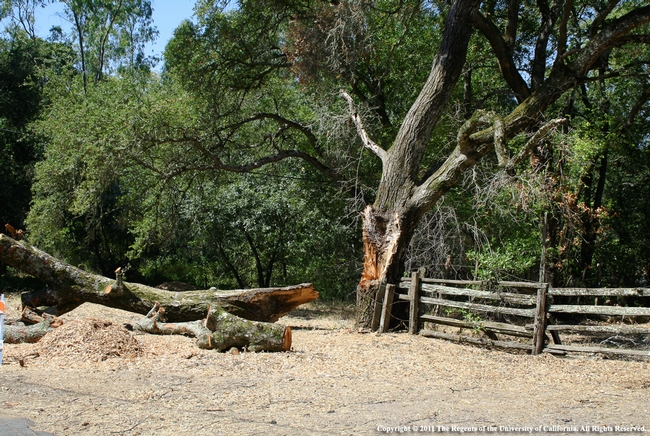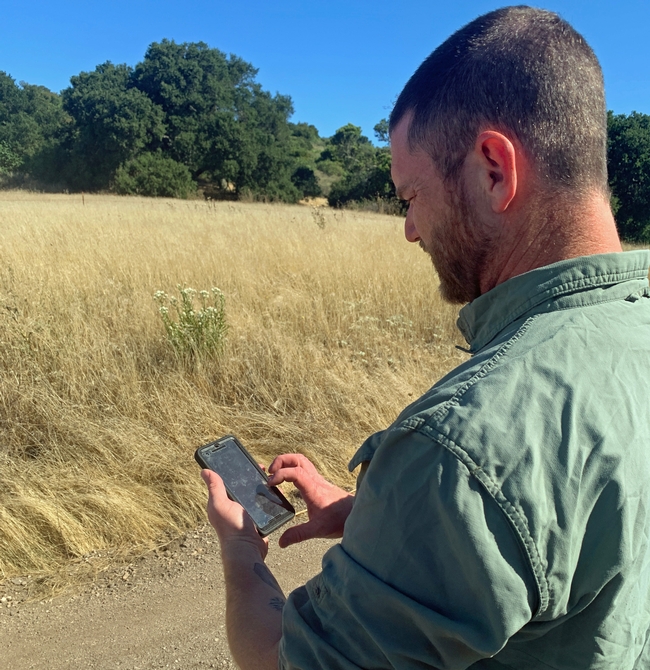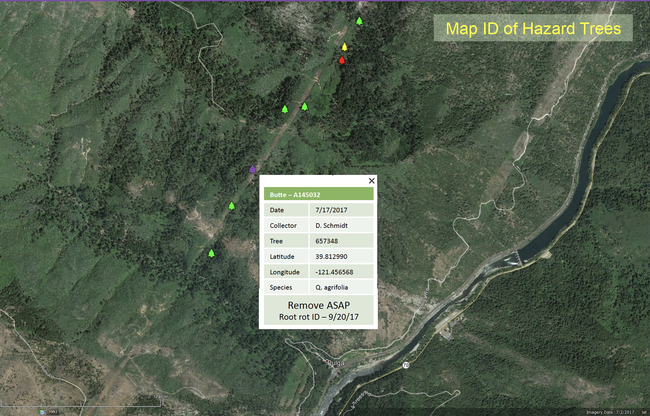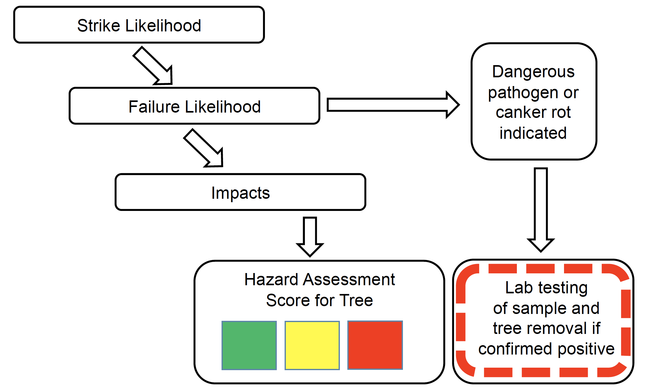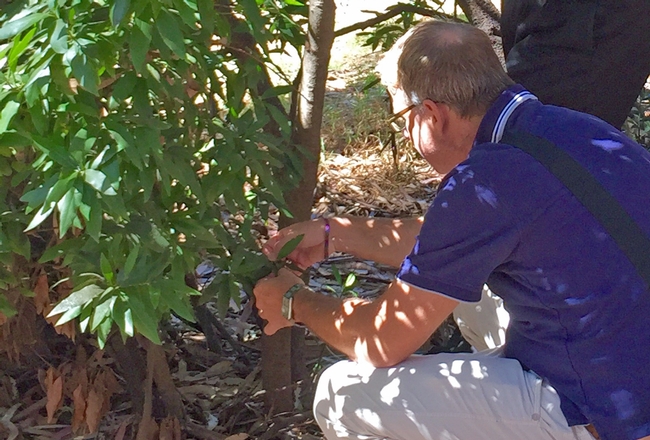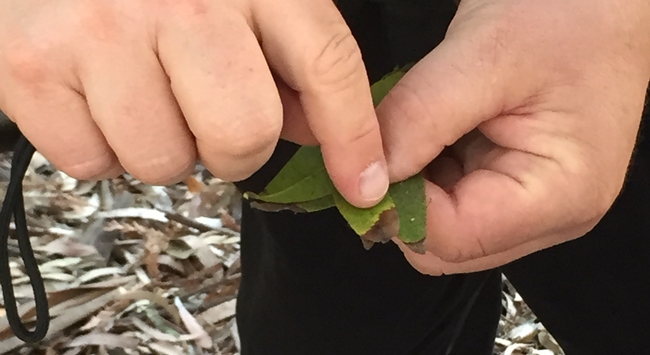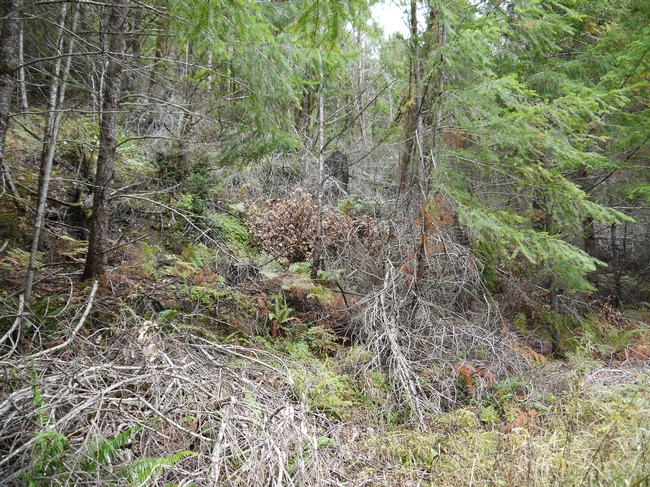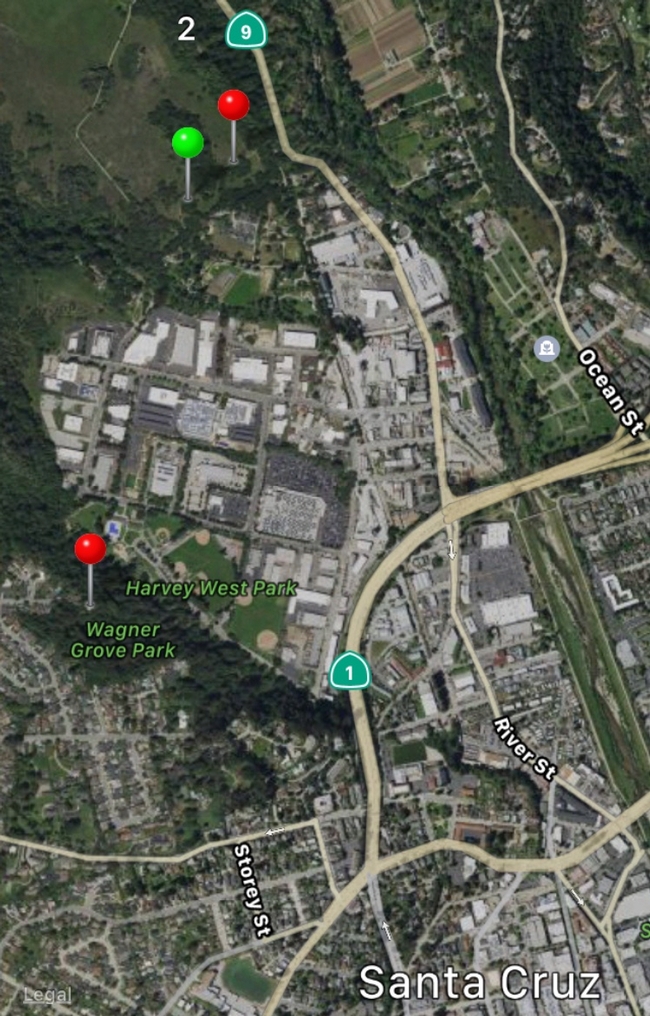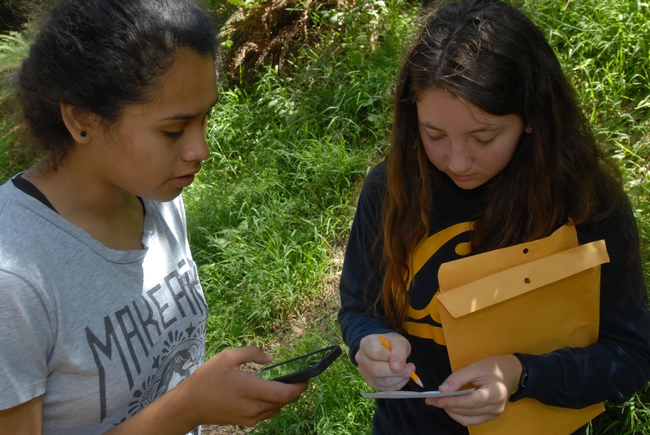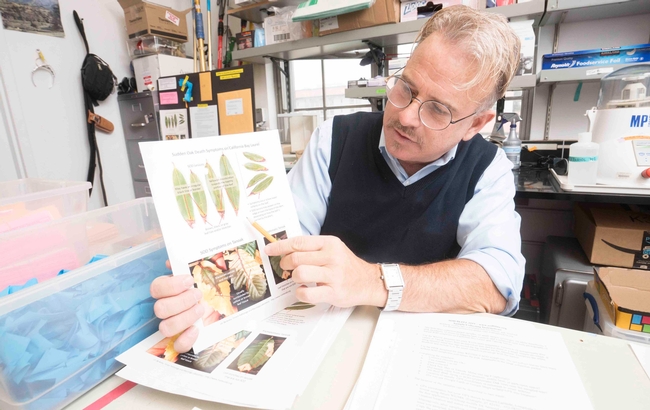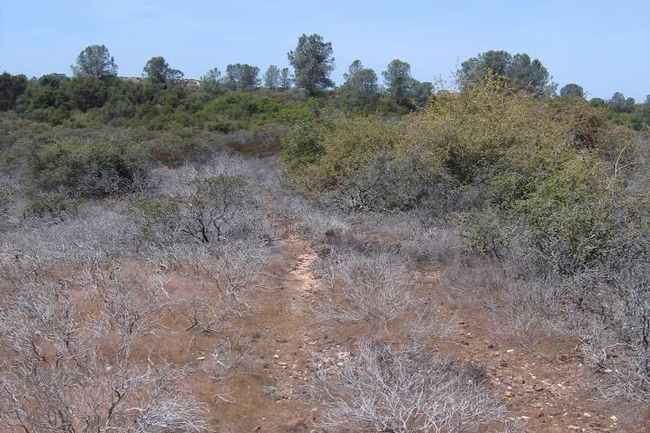Posts Tagged: Matteo Garbelotto
New mobile app identifies hazardous trees for public safety
"Trees are poems that the earth writes upon the sky,” wrote Kahlil Gibran. But trees falling into power lines have sparked catastrophic fires and falling trees have injured nature lovers.
To prevent power outages, PG&E looks for trees near power lines that need to be trimmed or removed. To prevent power outages and other mishaps caused by failing trees, Matteo Garbelotto, UC Cooperative Extension forest pathology specialist at UC Berkeley, has incorporated science into a mobile application that can be used to determine whether a tree presents a hazard and should be removed.
“PG&E was doing tree surveys with pencil and paper,” said Garbelotto, who saw the manual process as fraught with opportunities for error. A paper record needs to be sent to a central collection site where it is transcribed. In the transcription process, mistakes can be made. And there's no way of verifying if a person actually examined the tree to fill out the form.
“Why don't you do a digital survey?” he asked a PG&E tree surveyor. “Using a tablet or phone, the data could be shipped directly, in real time, to the San Francisco office. Using a phone or GPS device, you will know the precise location of the tree and know the worker did the job. If there's a fire, you have proof.”
PG&E Corporation Foundation, the philanthropic arm of the utility, gave Garbelotto a $70,000 grant to develop the app he envisioned for determining which trees are hazards.
“Developed by dedicated UC Berkeley researchers, the tool will provide benefits for other utilities and the forestry industry as they work to create safe and healthy forests. The easy-to-use mobile platform collects data in real time and creates a record that the survey was completed including relevant details like “when,” “where” and “who,” said Stephanie Isaacson, director of community relations for PG&E.
The UC Cooperative Extension tree disease expert created a list of questions that help evaluate tree health. For example, in addition to asking if the tree leaning toward a power line, surveyors are asked, Are there obvious signs of internal decay? Is there a large wound on the tree?
“If a tree has a wound of 5 inches or more, there is a good chance there is significant decay behind the wound,” Garbelotto said. “If there is a mushroom or conk growing on the tree, that portion of the tree is dead and the branch or whole tree may fall down.”
The app, which Garbelotto has dubbed “Evalutree,” can be used for more than powerline safety.
UC Berkeley Ph.D. student Michael Johnson has been using the app to evaluate different species of trees.
“We have just started our third field season using the app on a project for the Department of Defense that quantifies the health and economic value of the oak woodlands on the 100,000-acre Vandenberg Air Force Base,” said Johnson. “We started with coast live oak the first summer, added tanoak the second summer, and have expanded to bishop pine this summer.”
The mobile app has simplified data collection for Johnson, who is in the Forest Pathology and Mycology Lab at UC Berkeley.
“I used pencil and paper studying postfire aspen regeneration on Forest Service land in Northern Arizona in 2012-2013, where I also did my master's work on ponderosa pine decay in 2013-2015,” Johnson said.
He described his undergraduate work collecting data with pencil and paper carried in a tatum, a 8.5-inch by 12-inch metal case with a clipboard, compared with working with the Evalutree phone app.
“Each day would start with making sure that we had all of our data sheets packed in our bulky field tatums,” Johnson said, “making sure our GPS points were preloaded in a separate, expensive GPS device, making sure that our camera had batteries and that we had dry erase markers for our small white board so that we could indicate which plot each photograph belonged to.
“After the fieldwork was complete, we would spend weeks doing data entry, trying to make out the scrawled numbers and notes – smeared with charcoal and raindrops – and sorting and compiling the data, photos and GPS points. It was time-consuming and painstaking, to say the least.”
For his graduate research, Johnson was able to enter data directly into a spreadsheet on a field computer. “At the end of the field work, I would just have to compile the data from the computer, photos from the camera, and GPS points from the Garmin to make a report,” he said.
“Evalutree has changed all of that. Instead of field tatums and multiple bulky devices, I walk out into the field with a lab cell phone. The app has preloaded survey questions, the ability to connect photographs to specific plots, and drops GPS points at each plot and tree that I survey.”
Working in the U.S. Defense Department's sprawling, undeveloped landscapes, Johnson said, “We are often in the field all day without internet or phone connectivity. The app is prepared to meet this challenge and relies on our phone's internal storage and pre-existing GPS functionality to order and store our data with precision accuracy. At the end of the day – when we have returned to civilization and technology – we simply upload all of our surveys for the day and I immediately have my data and reports in multiple formats, including pdf, xls and kml files, at my fingertips.
“Within minutes, I can update my maps to show the exact location of all of the day's surveys, start crunching data in Excel, or print out a report with the photographs from each plot for my boss,” Johnson said.
Garbelotto, the UC Cooperative Extension specialist, would like to make the technology available to cities and companies that manage trees.
“The app can be used by any agency or government that owns or manages a significant number of trees and needs to run surveys on a regular basis to ensure these trees are not at risk of failing, causing property damage or, worse, casualties or injuries to people,” Garbelotto said.
“The surveys can be easily customized for different projects,” he said. “It can be used for campgrounds or parks to calculate the likelihood of a tree failing and likelihood of causing damage. You could have an answer within minutes of submitting the survey.”
For more information about Evalutree, contact Garbelotto.
This story was updated July 21 to add a quote from PG&E.
Citizen science SOD Blitz starts April 11 with new COVID-19 safety measures
With Californians sheltering in place to stop the spread of new coronavirus COVID-19, the annual citizen science project to map sudden oak death disease has been redesigned to ensure the safety of participants. The first in a series of SOD blitzes of 2020 will be April 11 in Napa. The events are free.
“We have been able to redesign the 2020 SOD Blitzes to make them a safe and legal activity that allows volunteers to exercise outdoors, and this powerful citizen science program will help us protect our forests' health,” said Matteo Garbelotto, UC Cooperative Extension forest pathology specialist and adjunct professor in the Department of Environmental Science, Policy and Management at UC Berkeley and event organizer.
Sudden oak death disease has killed more than 50 million of the state's iconic oaks and tanoak trees between Humboldt County and Monterey County, threatening survival of several tree species. In 2019 alone, 1 million tanoaks succumbed to sudden oak death, according to 2019 tree mortality data released by the U.S. Forest Service.
“The presence of new SOD strains is alarming and the SOD blitzes are the best, if not the only, program to intercept them before they spread,” Garbelotto said.
SOD Blitz volunteers will register online and take the training online at www.sodblitz.org to learn how to identify SOD symptoms and to carefully collect symptomatic leaves from California bay laurels and tanoaks. Collection and survey materials, which have been prepared in a sterile environment, will be picked up by participants at a local SOD Blitz station conveniently located near a parking lot. They can return samples to the same SOD Blitz station or by mail.
As citizen scientists, volunteers should focus on following safety guidance as well as adhering to research protocols. Social distancing – at least 6 feet away from other volunteers – and clean “housekeeping” rules will be strongly enforced when picking up or returning materials and during leaf collection.
For parents who are home schooling their children, this is an activity that the family can do together.
Garbelotto encourages tree care specialists to participate in the SOD blitzes.
“Besides offering free bay laurel and tanoak tests for their clients, we now offer tree care professionals free enrollment in UC Berkeley Forest Pathology Laboratory's OakSTePprogram, which allows them to test oaks for SOD infection,” Garbelotto said.
For more information, visit www.treefaqs.org or email the organizer of the SOD Blitz in your community (See schedule below).
Sudden Oak Death Blitzes 2020
All collection materials will be provided, but participants need a mobile phone or GPS device to install the free SODmap mobile app.
New format due to COVID-19
1. Training (30 minutes) and sign-up (5 minutes) must be done online at www.sodblitz.org before collecting the sampling materials at the SOD Blitz Stations in the locations specified below. Please sign up before you start the survey, and preferably when you take the online training.
2. Once at your local SOD Blitz Station you can pick up one or two collection packets following the social distancing rules of the State of California clearly specified in the online training. Stay at least 6 feet from other collectors. Bring your own pencil. Each packet allows you to sample 10 trees. Do not pick more unless you discussed it with the organizer.
3. Before you start the survey, make sure you have downloaded the free App “SODmap mobile” to determine the exact location of the trees you sample.
4. Each SOD Blitz has a start and end date, including the hour. You can pick up materials at the start time and you have to return your samples and any unused collection materials by the end date and cutoff time.
5. You can sample private properties with the owner's permission, alongside public roads and in parks or open spaces that are open to the public.
6. If you have any questions, please email your local organizer. Thank you so much for your participation.
Napa Blitz
Saturday, April 11 at 10 a.m. to Tuesday, April 14, 10 a.m.
SOD Blitz Station located on front porch of the Napa County Agriculture Commissioners Office Building 1710 Soscol, Napa
Please mail samples to UC Berkeley using the preprinted mail labels and postage included in each packet.
Contact: Bill Pramuk info@billpramuk.com
For a schedule of SOD Blitzes at other locations, visit https://nature.berkeley.edu/matteolab/?page_id=5095.
Volunteers needed to stop SOD from killing oak trees
“Two new dangerous SOD strains are at the doors of our forests,” said Matteo Garbelotto, UC Cooperative Extension forest pathology specialist in the Department of Environmental Science, Policy and Management at UC Berkeley. To assess the movement of SOD, he has mobilized citizen scientists for what he calls “SOD blitzes.” The first in a series of SOD blitzes of 2020 will be April 11 in Napa.
“We had some great results last year and participation continued to be good after 13 years of SOD blitzes,” Garbelotto said.
In Sonoma County, the 2019 SOD infection rate doubled that of 2018, and in Napa County, SOD detection was four times higher than the previous year. In the East Bay, between Richmond and San Leandro, SOD infection spiked – from 1% to 12%. The SOD infection rate tripled – from 6% to 18% on the western slopes of the Santa Cruz Mountains in San Mateo County.
As the disease expands its path of forest destruction, the UC Cooperative Extension scientist says more volunteers are needed to sample trees.
“The disease is moving to new counties outside of the current area of infestation,” Garbelotto said. “Even in our Bay Area neighborhoods, SOD of 2019 is not the same SOD of 10 years ago: different distribution, new local outbreaks, and new hosts are emerging, as the disease becomes more and more established in its new home.”
Garbelotto sees the SOD blitzes as the only hope for early detection of the new SOD strains.
“If these new strains arrived and spread in our forests, they could deliver a fatal blow to our forests,” he said. “By collecting symptomatic plant material in their neighborhoods, volunteers will make the most significant contribution possible to intercept these strains.”
Volunteers are taught to identify SOD symptoms and to carefully collect symptomatic leaves from California bay laurels and tanoaks. Participants in the SOD blitzes will be asked to quantify their efforts to stop SOD to show public interest in saving oaks and tanoaks when applying for funds to defeat the tree-killing disease.
Garbelotto is encouraging tree care specialists to participate in the SOD blitzes.
“We have enhanced the benefits for tree care professionals who participate in the blitzes,” Garbelotto said. “Besides offering free bay laurel and tanoak tests for their clients, we now offer them free enrollment in UC Berkeley Forest Pathology Laboratory's OakSTeP program, which allows tree care professionals to test oaks for SOD infection. It could be enormously beneficial to everybody.”
For more information about the SOD blitzes, visit http://ucanr.edu/sodblitz2020faq or www.sodblitz.org. See the 2020 SOD Blitz schedule at http://ucanr.edu/sodblitz2020.
2019 SODBlitz shows Sudden Oak Death on the rise in California
Sudden Oak Death (SOD), a serious exotic tree disease, threatens the survival of tanoak and several oak species in California. Currently, SOD infects trees in 14 coastal California counties, from Monterey to Humboldt. The disease, which was estimated to have killed over 50 million oaks and tanoaks over two decades, has changed the coastal forests composition in Northern California and Southern Oregon.
Though SOD occurs in patches, the overall infection area continues to grow with each passing year. Researchers had previously discovered that Phytophthora ramorum, the pathogen that causes SOD, most often spreads on the leaves of infected California bay laurel and tanoak. Forest managers can use proactive methods for controlling the disease — including sanitation, chemical treatments, and the targeted removal of bay trees — but such tools are preemptive in nature, only useful before oaks and tanoaks are infected. Timely detection of the disease in these species is therefore critical to slowing the epidemic.
With this in mind, UC Berkeley joined with over 30 local organizers in 2019 to assemble 25 SOD Blitzes staffed by trained volunteers. More than 400 volunteers were taught to identify SOD symptoms and to carefully collect symptomatic leaves from California bay laurels and tanoaks. Armed with this training, the teams surveyed 16,227 trees across 16 California counties, collecting approximately 9,000 leaves from 1,732 symptomatic trees. Samples were sent to the UC Berkeley Forest Pathology and Mycology Laboratory for processing and analysis.
The benefits of SOD Blitzes are becoming increasingly clear. Importantly, they educate the community about Sudden Oak Death, getting locals involved in detecting the disease while creating detailed maps of infected areas. Analyses of these maps help forest managers figure out where proactive measures, such as chemical treatments or tree removal, most effectively stop an infestation. All results from the data collection are made publicly available on SODBlitz.org, SODMap.org, and on the SODmap mobile app available at the Apple Store and at Google Play. (Results can also be accessed directly on the UC Berkeley Forest Pathology and Mycology Laboratory website.)
Using the app allows anyone to estimate the risk of oak infection, specific to their current location. While standing next to a tree of interest, a person can tap the app's “RISK” button and determine whether an oak is in danger of contracting SOD. In addition, results meetings and treatment training workshops will be held for the public in various Bay Area locations during fall 2019.
Matteo Garbelotto, UC Cooperative Extension specialist and adjunct professor in the Department of Environmental Science, Policy, and Management, has led the SOD Blitzes for 12 years. The program enrolls approximately 500 volunteers yearly to canvas California woodlands for symptoms of SOD. Results of the surveys are made available nearly in real-time, immediately after completion of the lab analysis.
“We estimate that as many as two to three million people may have accessed the SOD Blitz results to determine whether trees on their property may be at risk,” Garbelotto said. “This is a huge success and shows the great societal value that citizen science has, and it highlights the importance of collaborating with volunteers on issues that are relevant to safeguard trees that are an important part of California's natural heritage.”
2019 SOD Blitz Results
Across the state, the number of trees infected with SOD, along with the estimated SOD infection rate, has almost doubled since 2018. In some areas, infection rates were as much as 10 times higher than the previous year. These results suggest that the overall risk of oak infection by SOD is rising.
Spikes in the estimated SOD infection level at certain locations are particularly noteworthy; for example, from 1 to 12 percent in the western part of the East Bay between Richmond and San Leandro, including distinct outbreaks discovered in El Cerrito, Kensington and Berkeley. The western slopes of the Santa Cruz Mountains in San Mateo County have also seen an increase in SOD infection rate (from 6 to 18 percent), which may make safeguarding recreational venues and ecologically important forest sites more difficult. In Sonoma County, the 2019 SOD infection rate was approximately double that of 2018, and in the same timeframe, Napa saw a fourfold increase in detection. Peninsula towns between Redwood City and Los Altos Hills had a very high infection rate (21.6 percent) with an expansion of outbreaks to the east and north.
Some additional key results that came from the 2019 SOD Blitzes include:
- Two tanoaks were positive for SOD in a state park east of Crescent City in Del Norte County, marking the first report of SOD for the county. This was an important finding because, until 2019, Del Norte was the only county free of the disease in the area between the vast California infestation and the Southern Oregon outbreak. The SOD Blitz finding does not have immediate implications for regulations, but regulations will be imposed once CDFA can confirm the finding.
- An extensive survey of San Luis Obispo failed to identify SOD; however, multiple trees were found to be infected in the southernmost canyon of Monterey County. Previously, this canyon had only provided positive findings from water monitored by UC Davis scientists, but not from trees.
- Although Humboldt County has a few significant SOD outbreaks, and Trinity County has a marginal SOD outbreak in its southwestern border, SOD Blitzes in tribal lands in Humboldt and Trinity counties did not yield any SOD positives.
- San Francisco parks, including the Presidio, were negative for a second year in a row, suggesting that disease management practices have been successfully implemented in the area.
- Several cases were identified in the northern neighborhoods of the City of Napa. No positives had been found in this area since 2011.
- All isolates of the pathogen belonged to the NA1 lineage, which is more easily treated and common in the region. This is good news because of uncertainty about the potential virulence of the EU1 lineage recently discovered in Oregon forests.
A sampling of other noteworthy 2019 SOD Blitzes results follow. More results are available on the websites and app:
- The first infected Bay laurel was identified a few miles east of the town of Mendocino (Mendocino County) along the Comptche-Ukiah Road.
- Multiple SOD positive trees were identified between Guerneville and Duncan Mills in Sonoma County. The Russian River area has long been known to be affected by SOD.
- An outbreak was identified in southwestern Petaluma, while infestations were confirmed in Bennett Valley, Santa Rosa and east of Rohnert Park.
- Multiple infestations were identified in Marin County, including the ones northeast of San Rafael, Larkspur, Woodacre, Mount Tamalpais, Marin City and north of Inverness.
- In the Peninsula, SOD was identified in Burlingame Hills, northern Woodside, Emerald Hills, Palomar Park, Portola Valley. In Los Altos Hills and Loyola, SOD positive trees were detected both East and West of Interstate 280. An outbreak was detected west of Saratoga.
- High levels of infection were identified all along Skyline between Bear Gulch Road and Highway 17, and on the western slopes of the Santa Cruz Mountains between Skyline and Pescadero.
- SOD was confirmed between Felton and Santa Cruz and between Aptos and Santa Cruz.
- In Monterey County, the chronic Big Sur outbreak was once again confirmed to be active, while the disease appeared also in drier areas of the Carmel Valley, where it had been absent for a few years.
The SOD Blitz program was funded in part by the U.S. Forest Service's State and Private Forestry Organization and by the Midpeninsula Regional Open Space District. It was also made possible by a collaboration with the California Native Plant Society, CalFire, the Humboldt/Del Norte and Sonoma County UC Cooperative Extension, the Sonoma County UC Master Gardeners, the U.S. National Parks, California State Parks, the East Bay Regional Parks, the San Francisco Public Utility Commission, Mid-Pen Open Space, the UC Santa Cruz Arboretum, Santa Cruz Open Space, the Santa Lucia Conservancy, the Karuk and Hoopa Nations, the Mendocino Botanical Garden, the City and County of San Francisco Parks and Recs Office, and Strybing Arboretum. Many individuals, who have generously devoted their time and efforts, have been pivotal for the existence and success of the program.
READ MORE:
- Matteo Garbelotto: Leading the citizen science contagion
- First known cases of sudden oak death detected in Del Norte County
- SOD Blitz Project
- SOD Blitz map of results and summary table
Is habitat restoration actually killing plants in California wildlands?
In 2014, plant biologists with the California Department of Agriculture reported an alarming discovery: native wildflowers and herbs, grown in nurseries and then planted in ecological restoration sites around California, were infected with Phytophthora tentaculata, a deadly exotic plant pathogen that causes root and stem rot.
While ecologists have long been wary of exotic plant pathogens borne on imported ornamental plants, this was the first time in California that these microorganisms had been found in native plants used in restoration efforts. Their presence in restoration sites raised the frightening possibility that ecological restoration, rather than returning disturbed sites to their natural beauty, may actually be introducing deadly plant pathogens, such as those related to Sudden Oak Death, into the wild.
New work by a UC Berkeley team in the College of Natural Resources shows for the first time just how widespread and deadly the threat of pathogens from restoration nurseries may be.
The team surveyed five native plant nurseries in Northern California and found that four harbored exotic, or non-native, Phytophthora pathogens. Strains of the pathogens from native plant nurseries were shown to be at times more aggressive than strains found in the wild, and some of them are rapidly developing resistance to the fungicides that can be used to control them, the researchers found.
Working with restoration nurseries around the state, the researchers showed that new management techniques, coupled with new methods for detecting pathogens, can help these nurseries limit the spread of exotic pathogens.
"Some of these restoration projects cost tens of millions of dollars, but of course their actual value is much higher, because of the wealth of services healthy natural ecosystems provide, including supporting animal and plant biodiversity, providing good water and air quality, and enjoyable recreation sites," said Matteo Garbelotto, UC Cooperative Extension specialist and adjunct professor of environmental science, policy and management at UC Berkeley.
"Such services are highly diminished in ecosystems affected by exotic plant diseases, while water runoff and erosion, the establishment of exotic plants and animals, and even hotter wildfires may increase in conjunction with disease outbreaks in natural ecosystems," Garbelotto said.
Pathogens evolve to outwit fungicides
Bacteria that make humans sick are constantly evolving to resist the antibiotics designed to fight them, and resistance to fungicides has been documented in microbes causing diseases in agricultural plants. Garbelotto and his team wanted to know if the widespread use of fungicides in in native and ornamental plant nurseries could also accelerate the development of fungicide-resistance in plant pathogens.
Their research was spurred in part by their discovery of a new strain of the Sudden Oak Death pathogen in Oregon forests that is highly tolerant of a fungicide commonly known as phosphite, one of the main weapons used against plant parasites in the wild because its application does not cause any known negative environmental side effects.
Together with a group of New Zealand researchers, they decided to study fungicide resistance of Phytophthora -- a genus of plant pathogens that can case lethal cankers and root rot -- to two important fungicides, including phosphite.
The researchers gathered numerous samples of Phytophthora from 11 species present both in forests and plant nurseries. They then tested the sensitivity to phosphite of multiple individuals per species.
While most of the species tested were overall still sensitive to phosphite, strains of four species were able to resist the effects of the chemical, the researchers report in PLOS ONE. These include Phytophthora ramorum, the parasite behind Sudden Oak Death in North America and Sudden Larch Death in Europe, and Phytophthora crassamura, a species first discovered recently by the same UC Berkeley researchers in native plant nurseries and restoration sites in California.
Some strains within each of these four species, although genetically almost identical to strains still susceptible to phosphite, were resistant to it. The presence of chemical tolerance or chemical sensitivity when comparing nearly genetically identical strains suggests that the development of resistance occurred relatively recently, perhaps in response to the widespread use of phosphites in native and ornamental nurseries, Garbelotto said.
"These pathogens can be literally flooded with these chemicals in plant production facilities, and at the beginning of the study, we hypothesized that in such predicaments these pathogens would be forced to evolve resistance" Garbelotto said. "Indeed, our hypothesis was correct, and we found that some of them evolved the ability to tolerate exposure to phosphite."
While phosphite can still help to spur a plant's immune system, this may not be enough to quell the spread of the disease, Garbelotto said.
"By pressuring these pathogens to evolve resistance to phosphites, we are effectively taking out phosphite as a potential tool to manage these disease outbreaks," Garbelotto said. "Furthermore, the ability to quickly develop tolerance to a fungicide may be an indication these pathogens can adapt quickly to new environments. Thus, they may become formidable invasive organisms, infesting larger swaths of natural areas and causing significant disease and mortality of essential native flora."
A widespread - but reparable - problem.
Since the first discovery of Phytophthora in California restoration sites, research by the UC Berkeley team and others have traced the deaths of wild trees and plants back to strains of the pathogen originating in native plant nurseries, rather than strains already found in the wild. However, few studies have documented just how prevalent the problem is.
In a recent study published in the journal Plant Pathology, UC Berkeley researchers examined 203 individual plants across five restoration nurseries in California and found that 55 of the plants were infected with Phytophthora.
"We were able to prove that this is a widespread problem in California," Garbelotto said. "Most of the stock that they used is infested, and the levels were very high. For some species more than 50 percent of the plants we tested were infected."
The team then worked with the infected nurseries to implement new best management practices to try to limit the spread of disease without the use of phosphite or of other fungicides. These simple guidelines, which included more careful management of water runoff and soil to reduce cross contamination, reduced the prevalence of disease to nearly zero a year after implementation.
"We were able to prove that after a year of following the guidelines, those facilities were clear of pathogens, and other facilities that did not follow the guidelines still had the pathogens," Garbelotto said. "As a result of these findings, people are now putting a lot of money and effort into making sure that the plants are clean, by following similar guidelines and by making sure that no fungicides are used to avoid the development of resistance."
Co-authors on the PLOS ONE study are Shannon Hunter of the University of Waikato in New Zealand and Nari Williams, Rebecca McDougal and Peter Scott of Forest Protection in New Zealand. Co-authors on the Plant Pathology study are L. Sims of UC Berkeley and S. Tjosvold and D. Chambers of the University of California Cooperative Extension.
This research was supported by the Endemic and Invasive Pests and Diseases Strategic Initiative of the University of California, Agriculture and Natural Resources; and by the San Francisco Public Utilities Commission in collaboration with the U.S. Forest Service (Region 5).

